Six types of discount strategies for small businesses
It’s no secret that discounts and promotions bring in more sales. That is if you do them right.
In theory, they seem easy enough for any business to implement. You take a product or a service, discount it, get new customers and boost revenue.
But in practice, discounts and promotions involve a high level of strategy and psychology that even the big brands sometimes get wrong.
What happens if you get it wrong? You turn a profitable long-term strategy into a discount craze that not only devalues the product or service but also cheapens your brand. This could mean the end of your small business.
So how can you discount products and services to maximise revenue and avoid hurting your brand?
In this post we’ll walk you through six types of discount strategies so you can decide which one’s right for your small business, and when it’s best to use it.
But first, there are two key steps you can’t afford to skip:
Set your goal(s)
The biggest mistake you can make is to implement discounts blindly, whenever you feel like or without first setting a goal.
Before offering a hot new promo, make sure you decide on the goal you want to achieve. This goal will help you to determine the type of discount you offer, how you’ll promote it, and which group of customers you want to reach.
Here are some of the goals you can aim for:
- Gain new customers. If you want to attract more potential customers to your website and get them interested in your products or services, offering a discount can help with that. You can use it to entice them to try out your product or service at a lower price, thus lowering risk on their part.
- Engage existing customers. You can use discounts to encourage brand loyalty so customers return to you and recommend you to others.
- Reward loyal customers. If you have a loyalty programme, you should use discounts to reward loyal customers. For example, when a customer spends a certain amount on your site, you can offer them a discount code on their next order as a thank you.
- Lure in customers who haven’t bought from you in a while. You can offer a discount that makes them want to return to you and become a repeat customer.
- Get rid of old or excess inventory. Sometimes, you just want to clear your old inventory. Or you may have excess inventory that you want to sell fast. If you think that these products wouldn’t sell at the current price, then you can try running a promotion to nudge people to buy them.
Once you’ve set the goal or goals for your promotion, you can move on to step two, which is just as critical to your success as this first one.
Segment your shoppers
If you’re running a promotion and offering it to everyone on your list, regardless of where they are in the buying cycle, it may not yield the results you want.
A better, more effective tactic is to segment your shoppers and tailor offers based on their preferences and purchase history.
For example, you can offer a bigger discount to new customers to motivate them to give your small business a chance and to gain their trust. Or you can target only customers who haven’t bought from you in a while and offer them a hard to resist discount to win them back.
Don’t know how to segment shoppers?
- Start by creating buyer personas. This allows you to determine which types of discounts to offer to each shopper category. Here’s a guide that explains why buyer personas are important and how to create yours.
- Segment your mailing list. This means creating different lists of subscribers and sending each specific group a relevant offer depending on where they are in the purchasing journey.
Once you’ve set your goals and segmented shoppers, it’s time to figure out which of the following discount strategies can help you to boost revenue.
Special discount for first-time visitors
When a visitor lands on your site for the first time, they may not know much about your business and offering. Even if you do offer a discount code right away, they might not take it. It’s normal. They don’t know whether they can trust to buy from you or whether you have what they’re looking for.
So what can you do instead to earn their trust while they get to learn a bit more about your business, products and services?
You can offer them a discount in exchange for their email address.
This can be in a pop up, like in this example:
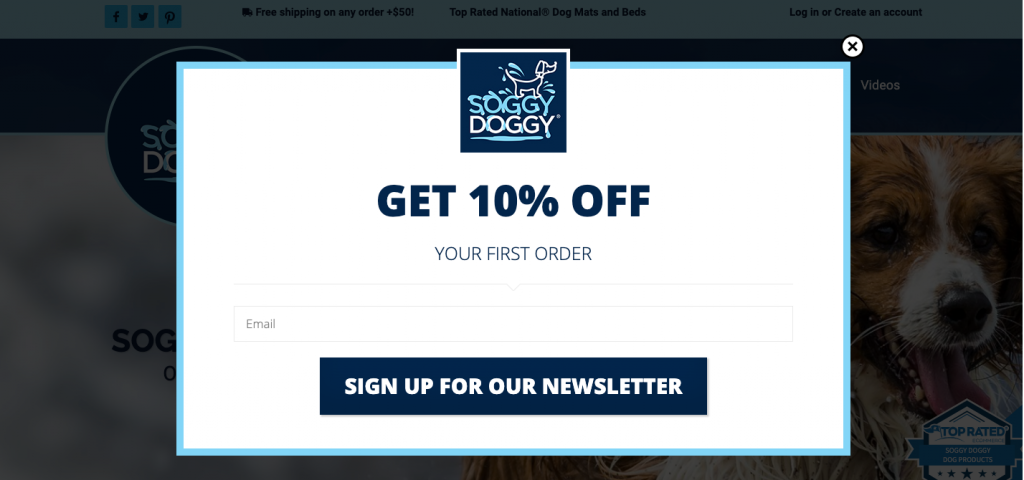
Or in a mailing list subscribe box that’s permanent on your website, like in this example:

You can even take it one step further. When emailing their discount, make it time-sensitive to motivate prospects to use it and buy from you in the next 24 hours to 30 days.
Check out this example:
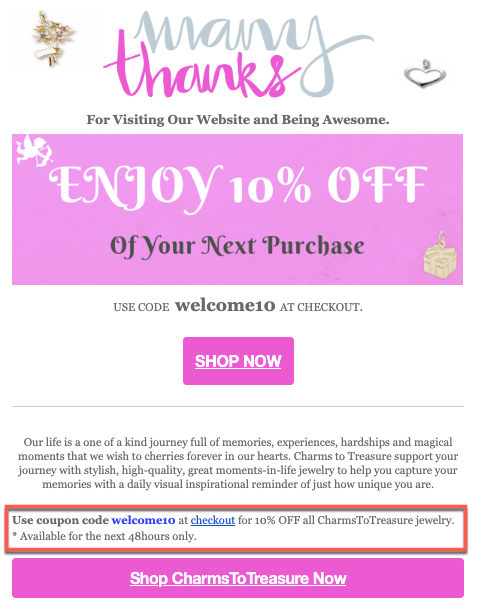
A great thing about this tactic is that it helps you to build or grow your email list so that you can encourage future orders as well as nurture one-time customers and turn them into loyal customers.
Rewarding loyal customers
You should never take your loyal customers for granted. Instead, make sure they know how much you appreciate their repeat business.
A great way to do that is by offering a discount. Just make sure you take into account their purchase history with you. Why? Because there’s nothing more annoying for a customer like receiving offers that are in no way relevant to what they previously bought from you.
In other words, always send relevant offers because 76% of customers want personalised offers based on what they previously bought from a site.
So, for example, when a customer spends a certain amount on your site, you can offer them a discount code to use on their next order or on a specific category of products or services as a thank you.
Reduce abandoned carts
Offering a discount to motivate shoppers to return to their cart and complete their order is a popular tactic to reduce abandoned carts.
However, this one’s tricky. Why? Because if you give out discounts to every user who abandons their cart, it won’t be long until others will become aware.
The result? Visitors will abandon just to get their hands on a discount, which will harm your bottom line.
So while this strategy is effective, use is sparingly.
One way to do it is to send a reminder email a day or two after a prospect abandons their cart, and incentivise them to complete their purchase.
Here’s an example:
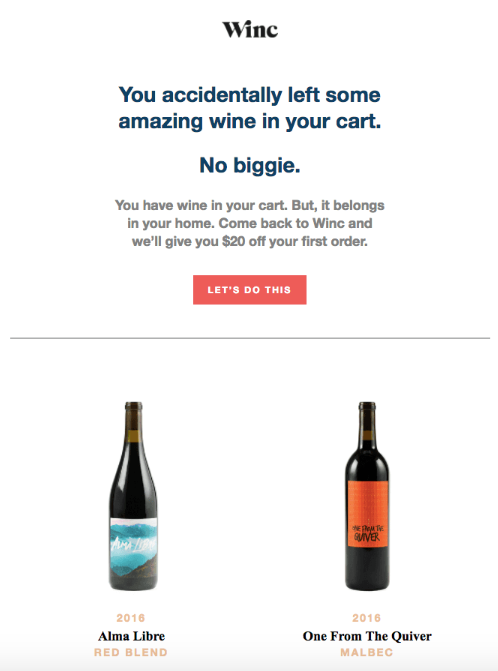
Read this post to learn more about the different types of abandoned cart emails you can send to bring shoppers back.
Event and seasonal discounts
Holidays like Valentine’s Day, Father’s Day or Christmas, or special events like birthdays are excellent occasions to run promotions and increase sales.
In the example below, Peloton offers a discount for Father’s Day, a day when lots of people tend to buy gifts for their fathers.
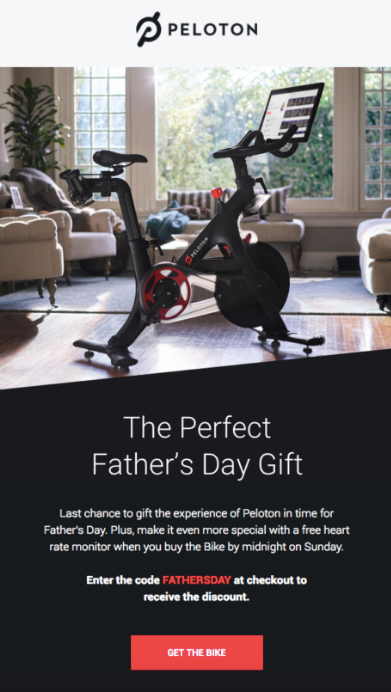
Of course, you can also offer discounts during popular discounting days, such as Black Friday or Cyber Monday.
Subscription discounts
You can also offer a discount to people who are willing to pay for your products or services in advance.
This type of discount is most popular among software-as-a-service businesses where customers can select between monthly and annual billing.
Here’s an example from Dropbox:
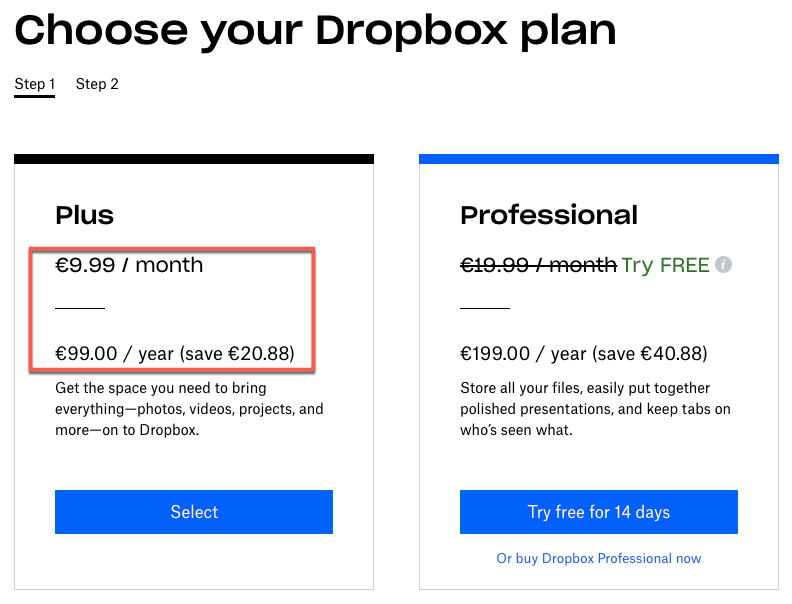
The idea is that customers who choose to pay annually are rewarded with a discount.
Now, this doesn’t mean you have to be a SaaS business to embrace this strategy. Here’s an example from a food subscription box:
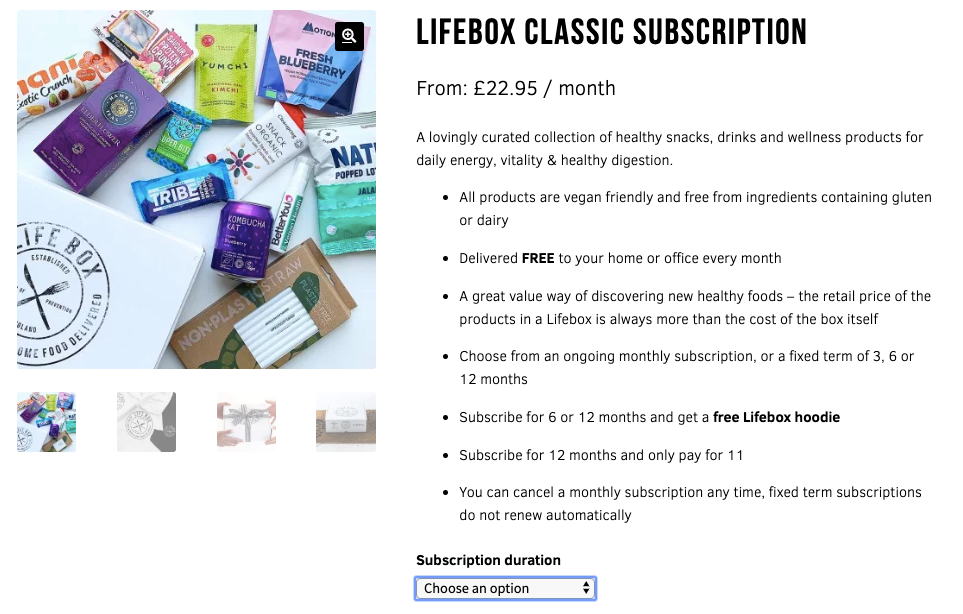
Discounts to encourage referrals
People trust other people. That’s why reviews and recommendations from customers are so effective at getting prospects to try out products and services they’re not familiar with.
So one final discount strategy you can put into action is this: encourage customers to refer your business to their friends and loved ones by offering a discount to either the referrer or the referral, or both.
Here’s a simple example:
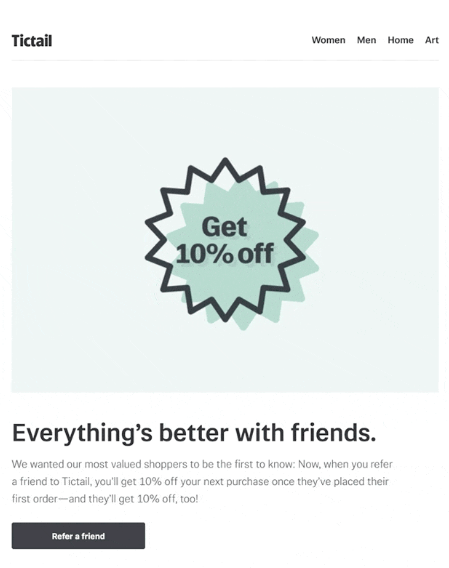
You can also make this offer permanent by adding it in the footer of every email you send to your customers.
In conclusion
The discount strategy that will get you the best results depends on your type of business, offering and customers. The easiest way to figure out which one’s the winner? Experiment with each of these tactics (and others) and see which one(s) work best for your small business.
One thing to keep in mind though: don’t discount your products and services too often, and never without first setting a goal. If you do, it might harm your business and bottom line since customers might put off purchase until you run a promotion again.
